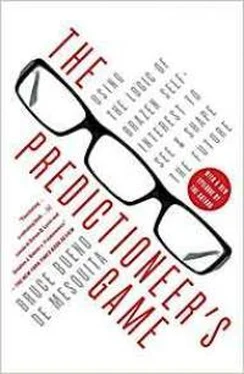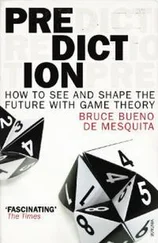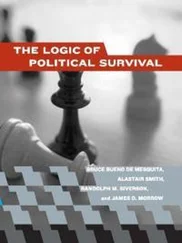Now we have two first-cut ways to predict what is likely to happen. Taking the two together, we can be fairly confident (still ignoring vetoes) that the solution to North Korea’s nuclear problem lies somewhere between the initial, majority-power approximation (about 80 on the issue scale in figure 4.1) and the weighted mean position (60 on the issue scale). That easily, we have created pretty reliable initial forecasts for this issue—a narrow range within which a resolution is likely to be found if no one exercises a veto. The initial forecasts mean substantively that at the outset there was a possible resolution supporting a slow reduction in North Korea’s nuclear capability followed by U.S. diplomatic recognition of the Democratic People’s Republic of Korea. I will say more about that in a moment.
The really simple power-majority view coupled with the slightly more complicated weighted-mean view offers a good answer to the range of likely agreements, but they do not result in the best prediction possible. That takes a computer program to calculate the solution to a game in which players make policy proposals and try to exploit each other’s egos to alter stances, climb over or reshape the mountains of power that lie in their way, and get the outcome they want. Still and all, there’s now enough information to make a pretty reliable prediction. This baseline forecast is likely to be right around 70 to 75 percent of the time. 4
Take a look back at the hills and valleys in figure 4.2, remembering that we are looking at the lay of the land in 2004. Doing so helps us understand that being really powerful does not assure success. The tallest mountain, the biggest mass of power, supports the idea that North Korea should completely eliminate its nuclear program in exchange for concessions. That mass of power supports an outcome around 80 on the issue scale (figure 4.1). This was not Kim’s point of view, it was not Bush’s point of view, and it also was not the weighted mean power’s point of view. That mean power perspective, located at the position labeled “Some Reduction /U.S. Recognition,” actually had the smallest bloc of power behind it. Although not supported by many, it was nevertheless the position around which an initial compromise might most easily have been constructed. That means that in 2004 one of the first-cut predictions included the prospect that North Korea could be induced to reduce substantially, but not eliminate, its nuclear capability in exchange for significant U.S. concessions, including perhaps even diplomatic recognition and certainly including consequential foreign aid (not shown on the figure).
Of course, this forecasting method doesn’t tells us how to get Kim Jong Il and President Bush to agree to the position it represents or to some other result that could be successfully negotiated. That’s where game theory comes in. Still, it is interesting to realize that, except for working out how to get Kim and Bush to agree to this result, we now have, with one of our baseline forecasts (and the forecast that ultimately came out of the computer-simulated game), a prediction, made in 2004, that is very close to the actual deal struck between the United States and North Korea in 2007.
Let’s think now about the game theory side to see the logic that produces a successful result and to get at some of the nuances of that result. For starters, we should notice that although North Korea is often portrayed in the media as a closed society, a mysterious place about which we know very little, the truth is that there are plenty of excellent experts in universities and elsewhere who know a lot about North Korea’s government and its leaders. I interviewed three experts, two together and one separately, and they came up with quite reliable information even though they disagreed about what they thought would happen in the so-called six-nation talks. As I intimated earlier, getting the data is not that hard. The more difficult question is how to frame the issue so that we answer the right question.
A good approach to solving problems such as presented by North Korea’s nuclear program begins by asking why that country’s leaders would want to develop nuclear weapons in the first place. We can think of that as asking, “What are they really demanding in the international arena?” The superficial answer might be to say that they want to threaten the Republic of Korea or American interests in the Korean peninsula. That may have merit but is unlikely to provide the whole answer, or even the main answer. I believe a good place to examine any provocative policy is to ask how that policy affects the prospects of political survival for the incumbent leadership that is engaging in provocation. Remember, this is human nature we’re talking about.
Kim Jong Il knows what it takes to retain the loyalty of his military leaders and to keep rivals at bay for years on end. He knows whom to antagonize and whom to placate. He certainly understands that he couldn’t defeat a concerted effort by the United States or South Korean governments to overrun North Korea and overthrow his government. But he also understands that he could raise the price of an invasion sufficiently that such an effort would be too costly to consider. In that case, by building a nuclear weapons capability he diminishes or even eliminates the most significant foreign threat to his political survival, freeing himself to concentrate on managing relations with his military leaders, party elites, family members, and senior civil servants. They, of course, could form various coalitions that might threaten his hold on power. Keeping them happy must be a primary concern for Kim Jong Il.
If personal political survival is Kim’s main concern—and I believe that this is every leader’s top priority—then it’s likely that there never was an intractable contradiction between his interest in sustaining himself in power and the United States’ interest in eliminating any nuclear threat from North Korea. That means all that we had to do was find a self-enforcing approach that provides real commitments on both sides and advances both the elimination of North Korea’s nuclear threat and external threats to Kim Jong Il’s political survival. That was the strategic problem as I saw it in 2004. My investigations painted a picture of Kim Jong Il as an astute politician whose primary interest in nuclear weapons was as a lifeline to staying in power. Looking at several simulations of his strategic interplay with other powerful North Koreans also made evident to me that he is less monolithic a leader than is sometimes thought in the United States and that he was, and remains, more open to compromise than is generally assumed. What, in 2004, did I contend such a compromise might look like?
I concluded that his demand really was “Assure my security against a foreign invasion.” Therefore, the counterdemand had to relate to assuring us that his nuclear threat became moot in exchange for our ensuring his political survival. This meant turning attention away from just threatening Kim to finding a way to make his interests and the international community’s interests compatible. Thinking through his interests as well as the interests of others, it becomes clear that any successful compromise requires that the international community be assured that as long as it does nothing to jeopardize Kim’s political survival, he will do nothing to jeopardize peace on the Korean peninsula or beyond.
In practical terms this meant that the United States directly, or through third parties, needed to guarantee, and I mean really guarantee, not to invade North Korea. The United States also needed to guarantee a sufficient flow of money—we will call it foreign aid—so that Kim Jong Il’s key domestic backers would be assured of receiving substantial personal, private rewards from him. These rewards include money that could go to their secret bank accounts in return for their political loyalty to him. In return for his assured security and for a steady flow of money, the North Korean regime needed to provide a verifiable means of ensuring that its nuclear weapons program stopped. Assurances of his security would most likely come in two forms: formal, explicit Chinese guarantees to defend North Korea, and public American promises not to attack it. Making these guarantees public is critical, because secret assurances are just cheap talk. They are easily violated without imposing political costs on the guarantor who reneges. As for the assurance of a steady flow of money, we are probably talking about as much as $1 billion per year for as long as Kim Jong Il’s regime survives. That may sound like a lot, but think about how much was spent every day in Iraq for years on end, and at what additional price in American, allied, and Iraqi lives, and you’ll see that $1 billion a year is small potatoes.
Читать дальше












